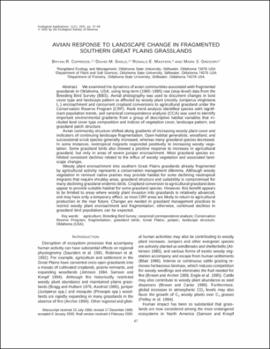| dc.contributor.author | Coppedge, Bryan R. | |
| dc.contributor.author | Engle, David M. | |
| dc.contributor.author | Masters, Ronald Edward | |
| dc.contributor.author | Gregory, Mark | |
| dc.date.accessioned | 2019-08-22T17:50:44Z | |
| dc.date.available | 2019-08-22T17:50:44Z | |
| dc.date.issued | 2001 | |
| dc.identifier | oksd_coppedge_avianresponseto_2001 | |
| dc.identifier.citation | Coppedge, B. R., Engle, D. M., Masters, R. E., & Gregory, M. S. (2001). Avian response to landscape change in fragmented southern Great Plains grasslands. Ecological Applications, 11(1), 47-59. | |
| dc.identifier.uri | https://hdl.handle.net/11244/321224 | |
| dc.description.abstract | We examined the dynamics of avian communities associated with fragmented grasslands in Oklahoma, USA, using long-term (1965-1995) raw (stop-level) data from the Breeding Bird Survey (BBS). Aerial photography was used to document changes in land cover type and landscape pattern as affected by woody plant (mostly Juniperus virginiana L.) encroachment and concurrent cropland conversions to agricultural grassland under the Conservation Reserve Program (CRP). Rank trend analysis identified species with significant population trends, and canonical correspondence analysis (CCA) was used to identify important environmental gradients from a group of descriptive habitat variables that included land cover type composition and indices of vegetation cover, landscape pattern, and grassland patch structure. | |
| dc.description.abstract | Avian community structure shifted along gradients of increasing woody plant cover and indicators of continuing landscape fragmentation. Open-habitat generalists, woodland, and successional scrub species generally increased, whereas many grassland species decreased. In some instances, neotropical migrants responded positively to increasing woody vegetation. Some grassland birds also showed a positive response to increases in agricultural grassland, but only in areas of severe juniper encroachment. Most grassland species exhibited consistent declines related to the influx of woody vegetation and associated landscape changes. | |
| dc.description.abstract | Woody plant encroachment into southern Great Plains grasslands already fragmented by agricultural activity represents a conservation management dilemma. Although woody vegetation in remnant native prairies may provide habitat for some declining neotropical migrants that require shrubby areas, grassland structure and suitability is compromised for many declining grassland-endemic birds. Cropland conversion to agricultural grassland does appear to provide suitable habitat for some grassland species. However, this benefit appears to be limited to areas where woody plant invasion into grasslands is relatively advanced, and may have only a temporary effect, as most CRP areas are likely to return to agricultural production in the near future. Changes are needed in grassland management practices to restrict woody plant encroachment and fragmentation; otherwise, continued declines in grassland bird populations can be expected. | |
| dc.format | application/pdf | |
| dc.language | en_US | |
| dc.publisher | Ecological Society of America | |
| dc.rights | This material has been previously published. In the Oklahoma State University Library's institutional repository this version is made available through the open access principles and the terms of agreement/consent between the author(s) and the publisher. The permission policy on the use, reproduction or distribution of the material falls under fair use for educational, scholarship, and research purposes. Contact Digital Resources and Discovery Services at lib-dls@okstate.edu or 405-744-9161 for further information. | |
| dc.title | Avian response to landscape change in fragmented southern Great Plains grasslands | |
| osu.filename | oksd_coppedge_avianresponseto_2001.pdf | |
| dc.description.peerreview | Peer reviewed | |
| dc.description.department | Rangeland Ecology and Management | |
| dc.description.department | Plant and Soil Sciences | |
| dc.description.department | Forestry | |
| dc.type.genre | Article | |
| dc.type.material | Text | |
| dc.subject.keywords | agriculture | |
| dc.subject.keywords | breeding bird survey | |
| dc.subject.keywords | canonical correspondence analysis | |
| dc.subject.keywords | conservation reserve program | |
| dc.subject.keywords | fragmentation | |
| dc.subject.keywords | grassland birds | |
| dc.subject.keywords | great plains | |
| dc.subject.keywords | juniper | |
| dc.subject.keywords | landscape structure|oklahoma (usa) | |
